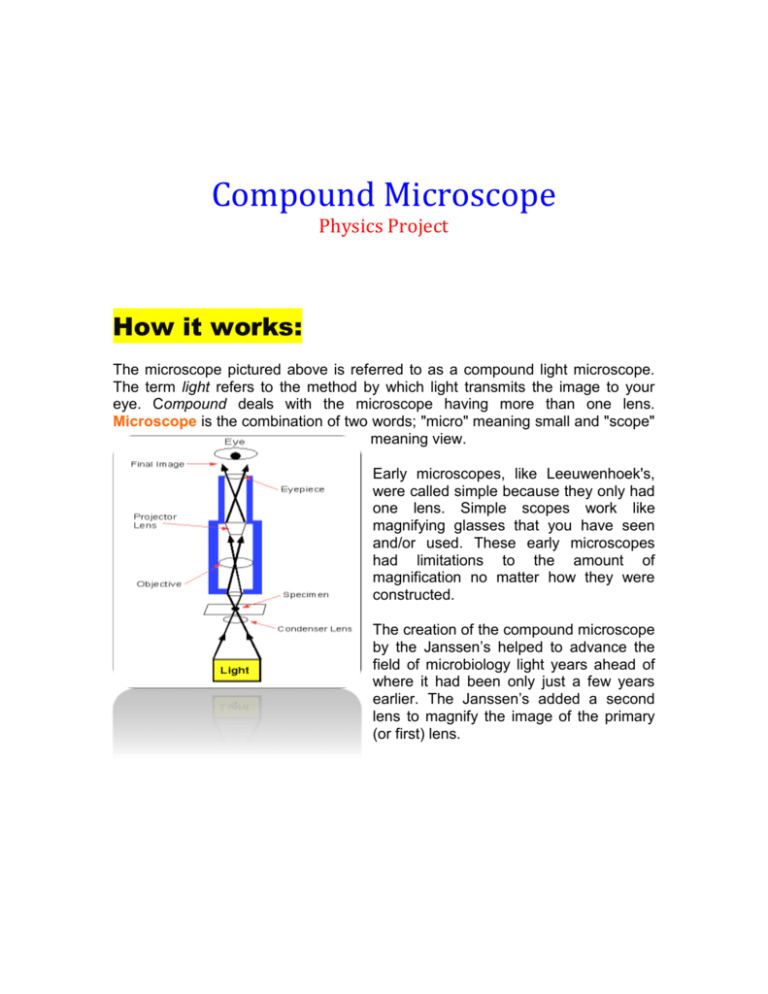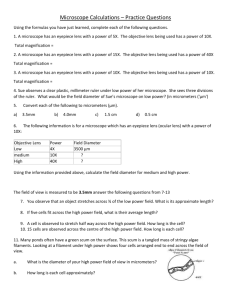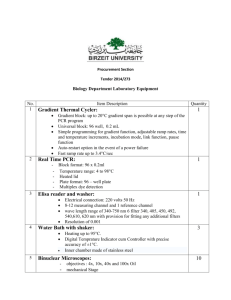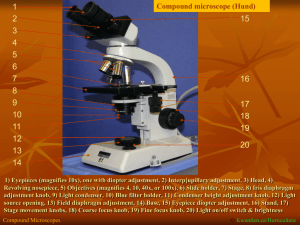Compound Microscope Physics Project: How it Works
advertisement

Compound Microscope Physics Project How it works: The microscope pictured above is referred to as a compound light microscope. The term light refers to the method by which light transmits the image to your eye. Compound deals with the microscope having more than one lens. Microscope is the combination of two words; "micro" meaning small and "scope" meaning view. Early microscopes, like Leeuwenhoek's, were called simple because they only had one lens. Simple scopes work like magnifying glasses that you have seen and/or used. These early microscopes had limitations to the amount of magnification no matter how they were constructed. The creation of the compound microscope by the Janssen’s helped to advance the field of microbiology light years ahead of where it had been only just a few years earlier. The Janssen’s added a second lens to magnify the image of the primary (or first) lens. Eyepiece Lens: the lens at the top that you look through. They are usually 10X or 15X power. Tube: Connects the eyepiece to the objective lenses Arm: Supports the tube and connects it to the base Base: The bottom of the microscope, used for support Illuminator: A steady light source (110 volts) used in place of a mirror. If your microscope has a mirror, it is used to reflect light from an external light source up through the bottom of the stage. Stage: The flat platform where you place your slides. Stage clips hold the slides in place. If your microscope has a mechanical stage, you will be able to move the slide around by turning two knobs. One moves it left and right; the other moves it up and down. Revolving Nosepiece or Turret: This is the part that holds two or more objective lenses and can be rotated to easily change power. Objective Lenses: Usually you will find 3 or 4 objective lenses on a microscope. They almost always consist of 4X, 10X, 40X and 100X powers. When coupled with a 10X (most common) eyepiece lens, we get total magnifications of 40X (4X times 10X), 100X, 400X and 1000X. To have good resolution at 1000X, you will need a relatively sophisticated microscope with an Abbe condenser Rack Stop: This is an adjustment that determines how close the objective lens can get to the slide. It is set at the factory and keeps students from cranking the high power objective lens down into the slide and breaking things. You would only need to adjust this if you were using very thin slides and you weren't able to focus on the specimen at high power Magnifying Objects/ Focusing Image: When viewing a slide through the microscope make sure that the stage is all the way down and the 4X-scanning objective is locked into place. Place the slide that you want to view over the aperture and gently move the stage clips over top of the slide to hold it into place. Beginning with the 4X objective, looking through the eyepiece making sure to keep both eyes open (if you have trouble cover one eye with your hand) slowly move the stage upward using the coarse adjustment knob until the image becomes clear. This is the only time in the process that you will need to use the coarse adjustment knob. The microscopes that you will be using are par focal, meaning that the image does not need to be radically focused when changing the magnification. To magnify the image to the next level rotates the nosepiece to the 10X objective. While looking through the eyepiece focus the image into view using only the fine adjustment knob, this should only take a slight turn of the fine adjustment knob to complete this task. To magnify the image to the next level rotates the nosepiece to the 40X objective. While looking through the eyepiece focus the image into view using only the fine adjustment knob, this should only take a slight turn of the fine adjustment knob to complete this task. Total Magnification: To figure the total magnification of an image that you are viewing through the microscope is really quite simple. To get the total magnifications takes the power of the objective (4X, 10X, 40x) and multiply by the power of the eyepiece, usually 10X. Videos Of Compound Microscope: Parts of a compound microscope https://www.youtube.com/watch?v=9nUseN_E-l0 How to Use a Compound Microscope https://www.youtube.com/watch?v=j5GuVIzDgrE&feature=related How to Correctly Use a Microscope https://www.youtube.com/watch?v=jP9HtcAvGDk&feature=related Websites That We Search: http://www.microscope-microscope.org/basic/microscope-parts.htm http://www.cas.muohio.edu/mbi-ws/microscopes/compoundscope.html#how http://www.cas.muohio.edu/mbi-ws/microscopes/Magnification.html







